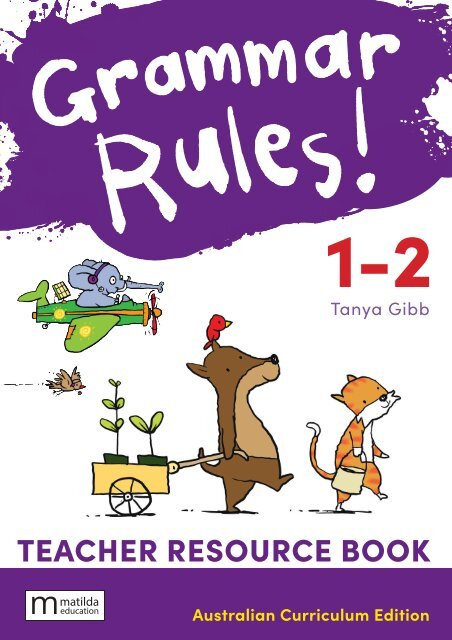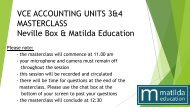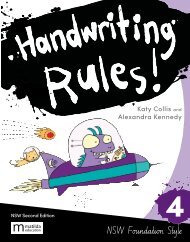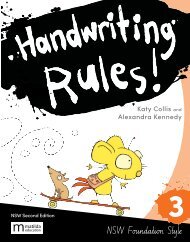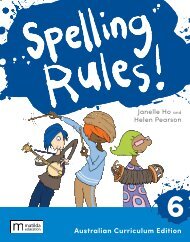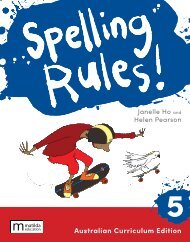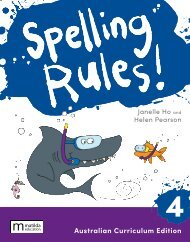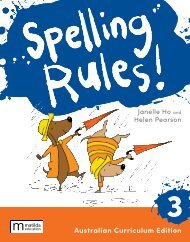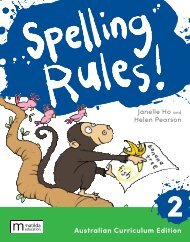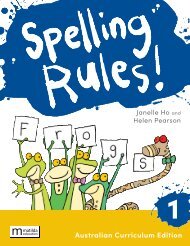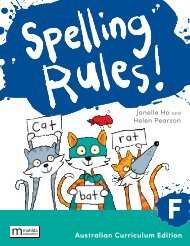Grammar Rules! 1-2 Australian Curriculum Teacher Book + Digital Download, 3e sample/look inside
- No tags were found...
Create successful ePaper yourself
Turn your PDF publications into a flip-book with our unique Google optimized e-Paper software.
1-2<br />
Tanya Gibb<br />
TEACHER RESOURCE BOOK<br />
<strong>Australian</strong> <strong>Curriculum</strong> Edition
Tanya Gibb<br />
TEACHER<br />
RESOURCE BOOK<br />
1-2<br />
<strong>Australian</strong> <strong>Curriculum</strong> Edition
<strong>Grammar</strong> <strong>Rules</strong>! 1–2 <strong>Teacher</strong> Resource <strong>Book</strong><br />
<strong>Australian</strong> <strong>Curriculum</strong> Edition<br />
ISBN: 978 0 6550 9255 1<br />
Designer and typesetter: Trish Hayes<br />
Illustrator: Stephen Michael King<br />
Series editor: Marie James<br />
Indigenous consultant: Al Fricker<br />
Acknowledgement of Country<br />
Matilda Education Australia acknowledges all<br />
Aboriginal and Torres Strait Islander Traditional<br />
Custodians of Country and recognises their<br />
continuing connection to land, sea, culture,<br />
and community. We pay our respects to Elders<br />
past and present.<br />
This edition published in 2024 by<br />
Matilda Education Australia,<br />
an imprint of Meanwhile Education Pty Ltd<br />
Melbourne, Australia<br />
T: 1300 277 235<br />
E: customersupport@matildaed.com.au<br />
W: www.matildaeducation.com.au<br />
First edition published in 2008 by Macmillan<br />
Science and Education Australia Pty Ltd<br />
Copyright © Tanya Gibb 2008, 2016, 2024<br />
The moral rights of the author have been asserted.<br />
All rights reserved. Except under the conditions<br />
described in the Copyright Act 1968 of Australia<br />
(the Act) and subsequent amendments, no part of<br />
this publication may be reproduced, in any form or<br />
by any means, without the prior written permission<br />
of the copyright owner.<br />
Educational institutions copying any part of this<br />
book for educational purposes under the Act must<br />
be covered by a Copyright Agency Limited (CAL)<br />
licence for educational institutions and must have<br />
given a remuneration notice to CAL.<br />
These limitations include: restricting the copying<br />
to a maximum of one chapter or 10% of this book,<br />
whichever is greater. For details of the CAL licence<br />
for educational institutions, please contact:<br />
Copyright Agency Limited<br />
Level 12, 66 Goulburn Street<br />
Sydney, NSW 2000<br />
Toll-free phone number (landlines only):<br />
1800066844<br />
Telephone: (02) 9394 7600<br />
Fax: (02) 9394 7601<br />
Email: memberservices@copyright.com.au<br />
Website: https://www.copyright.com.au<br />
Publication data<br />
Author: Tanya Gibb<br />
Title: <strong>Grammar</strong> <strong>Rules</strong>! 1–2 <strong>Teacher</strong> Resource <strong>Book</strong><br />
<strong>Australian</strong> <strong>Curriculum</strong> Edition<br />
ISBN: 978 0 6550 9255 1<br />
Printed in Australia by Courtney Brands<br />
Nov-2023
Contents<br />
Introduction .................................................. 4<br />
Glossary ..................................................... 5<br />
Teaching and Learning Activities ............................... 8<br />
Annotated Models for Different Types of Texts . . . . . . . . . . . . . . . . . . 16<br />
Assessment. . . . . . . . . . . . . . . . . . . . . . . . . . . . . . . . . . . . . . . . . . . . . . . . . . 26<br />
Analysis of Student Work Samples ............................. 27<br />
Student <strong>Book</strong> 1 . . . . . . . . . . . . . . . . . . . . . . . . . . . . . . . . . . . . . . . . . . . . . . . 37<br />
Scope and Sequence . . . . . . . . . . . . . . . . . . . . . . . . . . . . . . . . . . . . . . . . . . . 37<br />
Unit-by-Unit Activities to Enhance Learning ....................... 39<br />
Student <strong>Book</strong> 2 ..............................................54<br />
Scope and Sequence . . . . . . . . . . . . . . . . . . . . . . . . . . . . . . . . . . . . . . . . . . . 54<br />
Unit-by-Unit Activities to Enhance Learning ....................... 56<br />
Reproducibles 1–16. . . . . . . . . . . . . . . . . . . . . . . . . . . . . . . . . . . . . . . . 71–87<br />
Answers for Student <strong>Book</strong> 1 . . . . . . . . . . . . . . . . . . . . . . . . . . . . . . . . . . . 88<br />
Answers for Student <strong>Book</strong> 2 ................................... 92
The <strong>Grammar</strong> <strong>Rules</strong>! Series<br />
Introduction<br />
<strong>Grammar</strong> <strong>Rules</strong>! is an award-winning series of six student books and two <strong>Teacher</strong> Resource <strong>Book</strong>s, which have<br />
been reproduced in a new edition to support the <strong>Australian</strong> <strong>Curriculum</strong> English.<br />
The <strong>Grammar</strong> <strong>Rules</strong>! series provides a context-based approach to language and literacy teaching and learning.<br />
Students experience and respond to a range of model informative, imaginative, persuasive and hybrid texts.<br />
The content and scope of the texts exposes students to new concepts and ideas and develops students’<br />
knowledge, understanding and skills in listening, reading, viewing, speaking, writing and creating, as well as<br />
promoting students’ engagement with literature.<br />
<strong>Grammar</strong> <strong>Rules</strong>! shows students how grammatical structures and features function in texts to achieve<br />
meaning, from the contextual level of the whole text down to sentence and clause level and to the level of<br />
word groups, individual words and word parts. The series deals with the appropriate structures and features<br />
for particular types of texts, purposes for using language, and audiences.<br />
The student books and <strong>Teacher</strong> Resource <strong>Book</strong>s include Scope and Sequence charts. These charts<br />
give an overview of the whole program. They are also a useful index to the lessons and topics in each unit.<br />
<strong>Teacher</strong>s can use the English Program Checklist on Reproducible 14 (page 84) in their programs to keep<br />
track of the English concepts covered in class. The checklists are based on the Scope and Sequence charts in<br />
the <strong>Grammar</strong> <strong>Rules</strong>! student books. <strong>Teacher</strong>s can use the Comment column to write their evaluation of any<br />
teaching-learning activities undertaken with students and to note any follow-up activities required, or further<br />
comments.<br />
The student books include 35 units of work for students to complete, including six Revision Units, which<br />
can be used for assessment purposes. Each unit begins at the whole-text level with reading for meaning. These<br />
mentor texts can be used for discussion stimuli, analysis of text structures, forms and features, and as models<br />
for writing and for vocabulary expansion. Note that many students will need support to read the texts and to<br />
understand the vocabulary used.<br />
The series also covers punctuation and some aspects of spelling (plurals, suffixes, prefixes); literary elements<br />
such as onomatopoeia, rhyme and alliteration; and the function of visual elements including layout in a variety<br />
of texts. At the sentence and word level, focus is on choosing words for precision when creating texts; using<br />
understanding of text structures and conventions when speaking, reading and writing; and reading critically,<br />
for example, to reflect on character, setting and plot in a narrative; to identify causal and time sequencing in<br />
arguments and recount texts, and so on.<br />
Each unit concludes with a Try it yourself! activity. This activity enables students to further extend their<br />
understanding of the type of text as well as demonstrate their knowledge of the concepts covered in the unit.<br />
The Try it yourself! refocuses students’ attention on the influence of context and audience on language choices.<br />
Each <strong>Grammar</strong> <strong>Rules</strong>! student book includes a pull-out section with a Student Writing Log. The Writing Log<br />
provides a way for students to keep track of the types of texts and text forms they are writing, and the<br />
grammar they are attempting to use in the context of their writing. The Writing Logs support students’<br />
independence and encourage students to develop responsibility for their own writing/creating tasks.<br />
4
abstract noun<br />
a noun for something that cannot be seen, heard or<br />
touched, such as an emotion or an idea (love)<br />
adjective<br />
a word that tells more about a noun or pronoun<br />
(see also classifying adjective, describing/<br />
descriptive adjective, number adjectives)<br />
Glossary<br />
adverb<br />
a word that adds meaning to a verb (walk slowly),<br />
an adjective (very pretty) or another adverb (really<br />
well). Adverbs can tell how (quickly); when (soon,<br />
now, then); where (here, there, down).<br />
alliteration<br />
when words begin with the same sound (slippery<br />
slugs)<br />
antonym<br />
a word that means the opposite of another word<br />
(clean/dirty)<br />
article<br />
a small word (a, an, the) used in front of a noun or<br />
at the start of a noun group<br />
auxiliary verb<br />
see helping verb<br />
being verb<br />
a verb that shows being or having (is, has, was)<br />
classifying adjective<br />
a noun used in a noun group as an adjective to<br />
classify (gum tree)<br />
clause<br />
a group of words that expresses an idea and<br />
contains a verb (I caught the ball.)<br />
cohesion<br />
the way a text holds together; created through<br />
noun–pronoun referencing (Jorge – he), synonyms<br />
and substitution (tree – a home – lungs of the<br />
earth) and repetition (dark, dark wood)<br />
collective noun<br />
a name for a group of things (herd, flock, pack)<br />
command<br />
a sentence that tells someone to do something<br />
(Finish your work.)<br />
common noun<br />
an everyday naming word<br />
comparative adjective<br />
refers to both comparative and superlative adjectives,<br />
which are the forms of an adjective that show a<br />
degree of comparison (dirtier – comparative, dirtiest –<br />
superlative)<br />
complex sentence<br />
a sentence that has a main clause and one or more<br />
other clauses that add meaning to the main clause<br />
(If the dog barks, the cat will run away.)<br />
compound sentence<br />
consisting of two main clauses linked by a<br />
coordinating conjunction (I will walk and she will<br />
drive.)<br />
compound word<br />
a word made by combining two or more words<br />
(everywhere, anybody, someone)<br />
concrete noun<br />
a noun for something that can be seen, heard<br />
or touched<br />
conjunction<br />
a joining word that links words, phrases or clauses<br />
in a sentence (and, but, because, so)<br />
contraction<br />
a shortened form of a word or words where letters<br />
are left out. An apostrophe shows that a letter or<br />
letters have been left out. (I’m, what’s)<br />
coordinating conjunction<br />
a conjunction used to join two independent clauses<br />
in a compound sentence<br />
5
dependent/subordinate clause<br />
a clause in a complex sentence that depends on<br />
a main (independent) clause to fully make sense<br />
describing/descriptive adjective<br />
an adjective that describes aspects of a noun such<br />
as its size, shape, texture and colour (big round<br />
bumpy green frog)<br />
doing (action) verb<br />
a word that tells the actions (jump, eat, skip)<br />
emotive word<br />
a word that appeals to the emotions. Emotive<br />
words are often used in the media, in argument<br />
texts (the slaughter of whales) and in advertising<br />
(Don’t miss out!).<br />
evaluative language<br />
language that represents the author’s personal<br />
opinions and judgements about something (delicious<br />
food, brave explorer)<br />
exclamation<br />
a sentence that shows strong emotion, such as<br />
anger or surprise, or gives a warning or command.<br />
An exclamation ends in an exclamation mark.<br />
(Wow! Look out! I love it!)<br />
helping verb<br />
a verb that helps another verb (is sleeping,<br />
was running), also called an auxiliary verb<br />
homophone<br />
a word that sounds the same as another word but<br />
is spelled differently and has a different meaning<br />
(flour/flower)<br />
main/independent clause<br />
a clause in a sentence that makes sense on its own<br />
modality<br />
the degree of certainty, usualness or obligation<br />
the speaker or writer has about something. High<br />
modality is certain; low modality is less certain.<br />
(It will rain – high; It might rain – low;<br />
It won’t rain – high)<br />
noun group<br />
a group of words that contains a main noun and<br />
other words that tell more about the main noun<br />
(the football field, my new red shoes)<br />
number adjective/quantity adjective<br />
an adjective in the noun group that tells the<br />
quantity or order of a noun (every tree, some trees,<br />
five cakes, first term)<br />
onomatopoeia<br />
when words sound like the things they represent<br />
(whiz, clunk)<br />
paragraph<br />
a sentence or a number of sentences based on the<br />
same idea. A paragraph begins on a new line.<br />
personal pronoun<br />
a pronoun that replaces a noun for a person,<br />
place, animal or thing. Personal pronouns can be<br />
1st person (I, me, we, us), 2nd person (you) or 3rd<br />
person (her, him, she, he, them, they, it).<br />
plural noun<br />
the form of the noun used for more than one person,<br />
place, animal or thing (children, shops, birds, stitches)<br />
preposition<br />
a word that shows the relationship between a noun<br />
or pronoun and another word (on, in, under, below,<br />
around, through, with, by)<br />
prepositional phrase<br />
a preposition linked to a noun, pronoun or noun<br />
group. A prepositional phrase can tell where (under<br />
the old wooden bridge); when (on Monday); how (by a<br />
falling rock); with whom (with her); or what (with ice<br />
cream).<br />
pronoun<br />
a word that can replace a noun<br />
proper noun<br />
a name for a particular person, place, animal<br />
or thing, beginning with a capital letter (Timothy,<br />
Australia, Fido, Olympic Games)<br />
noun<br />
a word for a person, place, animal or thing (teacher,<br />
Australia, crocodile, desk)<br />
6
question<br />
a sentence that asks for information or an opinion.<br />
A question ends in a question mark.<br />
quotation marks<br />
marks used to show words that are spoken in<br />
quoted speech, also called inverted commas<br />
quoted speech<br />
the actual speech someone says. Quoted speech<br />
needs quotation marks (inverted commas).<br />
(‘The excursion is on Wednesday,’ said the teacher.)<br />
reported speech<br />
speech that is not quoted directly (The teacher<br />
said that the excursion is on Wednesday.)<br />
rhetorical question<br />
a question that doesn’t require an answer; used to<br />
encourage the listener or reader to think in<br />
a certain way<br />
rhyme<br />
when the ends of words sound the same (Humpty<br />
Dumpty)<br />
saying verb<br />
a verb that shows something is being said (yelled,<br />
whispered)<br />
sentence<br />
a group of words that makes sense. A sentence<br />
must include at least one verb. Sentences end in<br />
full stops, question marks or exclamation marks.<br />
synonym<br />
a word that has a similar meaning to another word<br />
(small/little)<br />
tense<br />
refers to the ways in which time is represented in<br />
the forms of the verb. Tense is described as past<br />
(I ran to school/I was running to school.); present<br />
(I am running to school/I run to school) and future<br />
(I will run to school/I intend to run to school<br />
tomorrow).<br />
thinking verb<br />
a verb for a mental activity (think, hope, wonder,<br />
decide, like)<br />
time connective<br />
a word that helps sequence events in a text<br />
through time (first, next, after, then)<br />
verb<br />
a being, doing, saying or thinking word<br />
verb group<br />
a group of words that does the job of a verb. It can<br />
contain a main verb and an auxiliary verb (should<br />
try, is dancing) or two verbs that contribute equally<br />
to the meaning (remembered feeling – this type is<br />
also known as a complex verb).<br />
simple sentence<br />
a sentence that consists of a single clause<br />
singular noun<br />
the form of the noun used for a single person,<br />
place, animal or thing<br />
statement<br />
a sentence that presents a fact or an opinion.<br />
A statement ends in a full stop.<br />
subordinating conjunction<br />
a conjunction used to join a dependent clause<br />
to a main clause in a complex sentence<br />
superlative adjective<br />
see comparative adjective<br />
7
Teaching and Learning Activities<br />
Displays<br />
Organise classroom displays of literature and update the displays regularly. Literature includes fiction and<br />
non-fiction from diverse contemporary, historical and cultural contexts. Ensure that you include texts by Aboriginal<br />
and Torres Strait Islander Peoples. Include examples of different types of texts across learning areas, including:<br />
factual books related to class topics<br />
picture books<br />
play scripts<br />
novellas<br />
novels<br />
poetry<br />
magazines<br />
advertising leaflets<br />
business letters<br />
informal letters<br />
scientific explanations<br />
emails<br />
travel brochures<br />
diaries and journals<br />
surveys<br />
questionnaires<br />
postcards<br />
comic strips<br />
board games<br />
song lyrics<br />
digital texts<br />
menus<br />
Displays can include texts that are beyond the reading levels of students in the class. Students can explore<br />
visual elements in these texts or have the texts read to them. Diagrams, labels, charts, flow diagrams, cycle<br />
diagrams, graphs, timelines, illustrations and maps provide visual support to assist readers’ understanding of<br />
texts. They can also be created by students as a demonstration of their understanding of a text.<br />
Students’ understanding of the structures and features of texts for purpose and audience is supported if texts used<br />
are in the context of school, home and community. For example, models of procedural texts could include: rules<br />
for maths games, rules for classroom behaviour, rules for sports, instructions for the tooth fairy about collecting<br />
teeth, directions to get to various parts of the school from the classroom, instructions for cleaning the class fish<br />
tank or caring for class plants, recipes for modelling clay or favourite family food treats, maps of the suburb or<br />
area, maps of the school grounds with routes marked in to various points, a plan of the classroom, a timetable<br />
for the day or week, a calendar of events for the year, a list of class jobs and a roster to show which students are<br />
responsible for which duties at any given time.<br />
Create class word banks and topic lists including word banks for aspects of grammar, such as a list of saying<br />
verbs other than said for students to use in their own writing, time connectives, prepositions, adverbs that tell<br />
how, maps with proper nouns for place names, singular and plural nouns, contractions, adjectives for particular<br />
book characters or animals, and so on. Add to word banks as the school year progresses.<br />
Display examples of students’ written texts that show writing for<br />
a variety of social purposes, topics and audiences.<br />
Provide different audiences for students’ spoken texts – peers,<br />
other classes, small groups, whole-school assemblies, family<br />
members, invited guests such as senior citizens, imaginary guests,<br />
characters in literature and so on.<br />
Make a ‘what we did today’ reflection chart or a ‘what we did this week’ reflection chart. It can be an A3-sized<br />
poster or a page of a scrapbook or a multimodal text, initially written by the teacher with students’ input but<br />
eventually written by pairs of students. It can be written towards the end of each day or week and displayed<br />
or posted online for family members and other students to read. It can include digital photos. The reflection<br />
chart will include aspects of recount and response, with different types of verbs (doing or thinking, and so on). It<br />
should include a summary of the day’s highlights or the week’s events with personal comments.<br />
8
Modelling and Demonstration<br />
Demonstrate for students how to write different types of texts. Construct texts in front of the class or a<br />
particular group of students. Tell students what you are thinking as you write. For example, when demonstrating<br />
the construction of a recount, talk out loud about chronological sequence, time connectives and past tense.<br />
Articulate for students why you have included particular events, what is significant about them and therefore<br />
why they belong in the recount. Model how you think about your writing as you write. This shows students that<br />
writers change their minds, reorder things, cross out, consider different ways to write things, choose ‘better’ or<br />
more precise words and self-correct as they write.<br />
Collaboratively create texts with students. For example, jointly construct a description after a class excursion<br />
to a park, nature reserve or botanical garden. Ask students to contribute adjectives to help describe<br />
what they have seen. Prompt them for figurative language such as simile by saying ‘the trees <strong>look</strong>ed like. . . ’.<br />
Students might also suggest descriptions that are examples of personification or metaphor. Ask students<br />
for suggestions about connecting the ideas in the text in a logical sequence, which verb groups would be<br />
appropriate and so on.<br />
Have students engage in collaborative language tasks in pairs or small groups where they discuss the purpose,<br />
structure and grammar of their texts. Collaborative and group work consolidates learning for those students<br />
who have learned particular aspects of language and supports and extends those students who are still<br />
developing in that area. Students who are more capable or who are gifted in verbal-linguistic intelligence<br />
deserve opportunities to work on language tasks together or with students in other classes, so that they can<br />
extend and challenge each other. Working in ability groups enables gifted students to extend and challenge<br />
each other.<br />
In any group work, encourage students to articulate for each other the language<br />
choices they are making when they collaboratively construct texts. Model this<br />
when you demonstrate how to create particular texts for particular purposes.<br />
Use published texts as models for innovation:<br />
Jack and the Beanstalk ➞ ‘Jenny and the Beanstalk’<br />
The Three Little Pigs and the Big Bad Wolf ➞ ‘The Three Mean Pigs and the Poor Little Wolf’<br />
Ten in the Bed ➞ ‘Ten in the Boat’<br />
We’re going on a Bear Hunt ➞ ‘We’re going on a Crocodile Hunt’.<br />
Activities to Support Learning<br />
about Text Structures and <strong>Grammar</strong><br />
Cloze<br />
Cloze involves deleting words or word groups from a text and asking students to use their knowledge of<br />
the way texts are structured and the grammar of texts to work out the missing words. When constructing<br />
cloze passages, make sure the text can still be read and makes sense. Keeping the first sentence intact is<br />
useful to help students establish the context. Some example cloze activities are included on Reproducibles<br />
1 and 2. These have been created from text <strong>sample</strong>s in Student <strong>Book</strong> 1. You could also read the cloze to<br />
students saying ‘blank’ where a word has been left out. Cloze works particularly well to identify students’<br />
understanding of noun-pronoun reference, articles, adjectives, verbs and verb tense. It is usually best to focus<br />
on one aspect of grammar only in each cloze activity. Students can complete cloze exercises either working<br />
independently or working in groups. Cloze passages are also a useful diagnostic tool for assessing grammar<br />
and reading comprehension.<br />
Jigsaw cloze involves cutting a text into chunks (paragraphs, sentences) and asking students to reassemble<br />
the pieces in the correct order. Jigsaw cloze works well to identify students’ knowledge of text structures,<br />
particularly procedures (directions, instructions and recipes), recounts, expositions and information reports.<br />
An example jigsaw cloze text is included on Reproducible 3. This has been created from a text <strong>sample</strong> in<br />
Student <strong>Book</strong> 1. Cut along the dotted lines to divide the passage into separate sentences, and have students<br />
9
eassemble the passage. Reproducible 3 can also be used for sentence cloze. Sentence cloze involves<br />
cutting a sentence into individual words or word groups (grammatical parts). Students need to use reading<br />
comprehension and understanding of grammar to reassemble them. Sentence cloze is particularly useful for<br />
lower primary students and students learning English as a second language. Oral cloze involves the teacher<br />
reading to students (particularly narratives), pausing during the reading and asking for predictions about what<br />
might happen next. Students need to identify aspects of the text that enabled them to make their predictions.<br />
Concept Maps and Semantic Webs<br />
When students brainstorm ideas or prior knowledge about a topic it is useful to collate this knowledge in a<br />
structured format such as a concept map or semantic web. Concept maps and semantic webs are visual ways<br />
of organising and recording lexical words or content words – the key words related to a topic.<br />
Concept Map<br />
Spiders<br />
What they <strong>look</strong> like Where they live Types of web How they get food Spider babies<br />
2 body parts in webs orb hunt egg sacs<br />
eight legs under rocks funnel trap<br />
fangs triangle ambush<br />
eyes<br />
tangled<br />
mouth<br />
spinnerets<br />
claws<br />
Semantic Web<br />
suitable<br />
breeds<br />
races<br />
jobs<br />
training<br />
assistance dogs<br />
sled dogs<br />
jobs<br />
history<br />
suitable<br />
breeds<br />
guide dogs<br />
Working dogs<br />
search and<br />
rescue dogs<br />
types of<br />
disasters<br />
crowd<br />
control<br />
chickens<br />
herding<br />
farm dogs<br />
protecting<br />
police dogs<br />
training<br />
jobs<br />
tracking<br />
sniffer<br />
dogs<br />
cattle<br />
sheep<br />
10<br />
When introducing a new topic to the class, brainstorm a list of questions that students have about the topic,<br />
such as What else would we like to know? Where does it live? How does it <strong>look</strong> after its babies? and use these<br />
questions to construct a concept map or semantic web.
Dramatisation<br />
Students can dramatise any narrative, poem, concept<br />
or situation. Dramatising narratives focuses students’<br />
attention on the structure of narratives. In the<br />
early stages, student dramatisation often includes<br />
a lot of talking but little understanding of the need<br />
for complication and resolution. The functions of<br />
orientation, complication and resolution can be made<br />
explicit during preparation of student dramas or after<br />
presentation or performance.<br />
Dramatising a narrative helps students to focus on<br />
the relationships between the characters and how<br />
this is demonstrated through language choices. The<br />
relationship between language users in a situation<br />
can be referred to as tenor. The tenor of a situation<br />
determines the way language is used. Dramatisation<br />
offers great opportunities for students to explore<br />
tenor as they take on roles as different characters<br />
in different situations. An example would be a<br />
group of six-year-olds play-acting a family scene in<br />
a supermarket where the student playing ‘the child’<br />
yells and dominates the parents. Most students in the<br />
audience would <strong>look</strong> to the teacher for confirmation<br />
that this behaviour is acceptable in a drama. The value<br />
of the drama is that it shocks, and challenges the<br />
accepted roles of parents and children. This creates<br />
an opportunity to discuss with students the way<br />
relationships in a situation determine which language<br />
choices are appropriate. (Dramatisation allows for<br />
planning and preparation for performance, whereas<br />
Improvisation – see page 13 – does not).<br />
Editing and Proofreading<br />
Editing is when students read over their work to<br />
ensure that it communicates what they mean. When<br />
students edit their work they <strong>look</strong> at aspects such<br />
as the structure and grammar of the text and their<br />
choice of vocabulary to convey the meaning they are<br />
attempting to make.<br />
When students are proofreading they are ensuring that<br />
their writing is ready for publication. Students need to<br />
understand that clear written communication requires<br />
correct spelling, punctuation and grammar.<br />
Scan a piece of writing that has some grammatical<br />
and/or spelling errors (such as a passage you have<br />
written yourself with deliberate errors, or a <strong>sample</strong> of<br />
a volunteer student’s work) and display it on an IWB<br />
to show students how to proofread a passage. The<br />
activity on Reproducible 4 requires students to<br />
check and correct verb forms, and is a useful tool for<br />
students to practise their proofreading skills.<br />
Epilogue<br />
An epilogue asks students to predict what happens<br />
beyond the end of a narrative. Students need an<br />
understanding of characterisation, time frames and<br />
issues in the narrative to create an epilogue.<br />
Have students create an epilogue for a picture book<br />
or other narrative or work in groups to create a<br />
performance that shows what could happen after the<br />
end of a narrative. Compare and discuss the validity of<br />
each epilogue presented. Students could also create<br />
prologues. A prologue would include events that<br />
took place before the start of the story, underpinning<br />
character behaviour and events in the story.<br />
Freeze Frames<br />
Freeze frames are a series of depictions or frozen<br />
moments in time in which a number of scenes are<br />
presented in sequence. Students create a scene,<br />
freeze to show the audience and then move<br />
into position for the next scene and freeze.<br />
The audience needs to close their eyes during<br />
the transitions between scenes so that the images<br />
they see are frozen depictions.<br />
Freeze frames are a good way to revise time<br />
connectives, as students need to establish time frames<br />
and sequences when creating each scene of their freeze<br />
frame. For example, a freeze frame sequence based on<br />
a family portrait might go like this:<br />
First the photographer arrived. Then the family got<br />
ready. Then the photographer set up the camera. After<br />
the family photos were taken, the photographer joined<br />
in for a group shot.<br />
Use the template on Reproducible 5 to create<br />
freeze frame cards. Write each scene for the<br />
sequence on the card and distribute the cards<br />
to groups of students.<br />
11
Games<br />
1. Verb/Adverb Improvisation Photocopy<br />
Reproducible 6 and cut out the cards. Place<br />
the verbs in a container. Place the adverbs that<br />
tell how in a different container. Have students<br />
play in teams. Have each team pick a word from<br />
each container and create an improvisation<br />
to illustrate both words together. Students<br />
themselves could create some more word cards.<br />
2. Alphabet Challenge Have students play in pairs<br />
and give each pair a copy of Reproducible 7.<br />
Randomly select a letter of the alphabet and tell<br />
students to write a word starting with this letter<br />
in each column, and shout ‘Stop!’ when they are<br />
finished. As soon as a team shouts ‘Stop!’, have<br />
all students stop and compare their answers.<br />
Every correct unique answer scores two points.<br />
If another team has the same answer, score one<br />
point only for that answer. The team who finished<br />
first gets a bonus point if all their answers are<br />
appropriate.<br />
3. What’s Your Answer? Create a deck of<br />
cards with a grammar term written on each card.<br />
For example: a saying verb, a doing verb, a proper<br />
noun in your school, a proper noun for a place in<br />
Australia, a describing adjective for a tree, a describing<br />
adjective for a person, a noun group, a sentence and<br />
so on. Place the deck face-down on a table. Have<br />
students play in groups. Students take turns to<br />
turn over a card. If they answer correctly they win<br />
the card. If they answer incorrectly the card goes<br />
to the bottom of the deck. The student with the<br />
most cards when the deck is finished is the winner.<br />
4. Quiz Have students create quiz sheets for their<br />
classmates. For example, a proper noun quiz has<br />
all proper noun answers. Questions could include:<br />
What is our teacher’s name? What is the name<br />
of our town? What is the principal’s name? What<br />
would be a good name for a goldfish?<br />
5. Find-a-word Ask students to create grammar<br />
find-a-words for each other to solve. The find-awords<br />
can focus on adjectives, common nouns,<br />
proper nouns, verbs or adverbs. A doing verb finda-word<br />
is included on Reproducible 8 to get<br />
students started.<br />
6. Label that Picture Create a set of picture<br />
or photo cards from travel brochures, magazines,<br />
newspapers and so on. Create a set of grammar<br />
cards labelled noun, noun group, verb, sentence,<br />
adjective and so on. Place cards in two piles<br />
face-down on a table. Have students take turns to<br />
turn over one of each card and give ten answers.<br />
For example, if they turn over a noun card, have<br />
them name ten nouns in the picture; if they turn<br />
over a card labelled sentence, have them describe<br />
the picture in ten full sentences.<br />
7. Concentration Have students play<br />
Concentration by pairing a label card with a<br />
picture card. For example, one matching pair<br />
would be a card labelled verb: eat and a card<br />
showing a picture of a person eating. Use<br />
Reproducible 9, or create your own cards.<br />
Shuffle the cards and place them in rows facedown<br />
on a table. Have students take turns to turn<br />
over pairs of cards. If the cards are a match, they<br />
keep the pair and have another turn. If the cards<br />
are not a match, they turn them face-down again.<br />
The student who has collected the most pairs at<br />
the end of the game is the winner.<br />
8. Noun Group Challenge Write common<br />
nouns on pieces of paper and place in a container.<br />
Have students play individually or in pairs. Select<br />
a noun from the container and call it out. Tell<br />
students to write the longest noun group they<br />
can for the main noun that you called out. Noun<br />
groups can include adjectives, phrases and clauses.<br />
If students are not yet familiar with the term ‘noun<br />
group’, tell them to use as many words as they<br />
can to describe the noun. For example: ‘desk’ –<br />
teacher’s desk, old wooden teacher’s desk, old wooden<br />
messy teacher’s desk, old wooden messy teacher’s<br />
desk with the cracked surface, old wooden messy<br />
teacher’s desk that is about to fall apart.<br />
9. Memory Out Loud Have students sit in a<br />
circle and take turns to list nouns taken on a<br />
picnic, seen at the zoo, bought at a shop, visible in<br />
the classroom, found in the home and so on. Each<br />
student needs to remember the items already<br />
listed and then add their own.<br />
12
I went to the zoo and I saw a bear.<br />
I went to the zoo and I saw a bear and a zebra.<br />
I went to the zoo and I saw a bear, a zebra and a<br />
hippo, and so on.<br />
The game could also be played using verbs.<br />
I went to the park to play.<br />
I went to the park to play and run.<br />
I went to the park to play, run and sing . . .<br />
10. Suggest a Word Create a deck of cards<br />
with grammar labels such as noun, verb, adjective.<br />
Add further terms such as proper noun, common<br />
noun, adverb as these are introduced to students.<br />
Students play by placing the deck face-down on<br />
a table. They then take turns to turn over a card<br />
and name a word for the label. If the word is<br />
correct according to the rest of the team or the<br />
adjudicator then they keep their card. Initially you<br />
might allow students a free turn when they answer<br />
correctly but as students become better at the<br />
game and better at grammar terminology you<br />
might need to revise the rules and not allow the<br />
free turns. The student with the most grammar<br />
cards at the end of the game is the winner.<br />
11. Categories Have a large number of examples of<br />
words for grammar categories such as common<br />
nouns (cat, dog, chair), doing verbs (run, skip,<br />
hopped), saying verbs (say, ask, yelled), proper<br />
nouns (Australia, Kevin, Bondi), adjectives (soft, sad,<br />
cheeky) and so on written on pieces of paper. Have<br />
students work in groups to place the words in<br />
their correct grammar categories. Students could<br />
compete in teams.<br />
12. Word Sorts Use word cards that have been<br />
used for various purposes in the room. Have<br />
students work in groups to sort the words by a<br />
criteria of their choice, such as past tense verbs,<br />
saying verbs, synonyms, adjectives that quantify,<br />
number of syllables, rhyme, alliteration, spelling<br />
patterns or any criteria is acceptable as long as<br />
students can justify their choices.<br />
13. Snap Create a deck of playing cards with a<br />
grammar label and <strong>sample</strong> word on each card<br />
(such as noun: cat or proper noun: Australia).<br />
Make sure that you have two or four cards<br />
for each word. Two or four students can play<br />
this game. Shuffle the deck and then deal each<br />
student an equal number of cards until all the<br />
cards have been dealt. Students take turns<br />
placing a card face-up on the table.<br />
When a pair is shown the first player to spot the<br />
pair calls ‘Snap!’ and snaps their hand on the pile.<br />
The aim is to collect all the cards. When the deck<br />
is finished and all the cards have been collected the<br />
person with the most cards is the winner.<br />
Hot Seat<br />
In Hot Seat, one student takes on the role of<br />
a character in a novel or a famous person in a<br />
historical recount, newspaper article, biography<br />
or autobiography. The rest of the class acts as<br />
interviewers or journalists and asks the student in<br />
the ‘hot seat’ questions about their thoughts, feelings<br />
and responses to events in their life. Hot Seat allows<br />
students to explore interview techniques and the<br />
structure of open-ended questions, point of view,<br />
modality and characterisation. Some answers will be<br />
based on evidence available to students in the text<br />
they have taken the character from. Some answers<br />
may not be readily evident but the person in the<br />
Hot Seat role should be able to extrapolate how<br />
their character would respond. The student in<br />
the Hot Seat will need to use thinking verbs to<br />
represent their point of view.<br />
Improvisation<br />
Improvisation involves students acting out a scene<br />
without rehearsal or script. It allows students to<br />
explore roles and relationships and use language<br />
for different purposes. Divide the class into<br />
groups then have groups improvise a scene that<br />
you suggest, such as ‘You are three friends talking<br />
about a teacher who you think was unfair about<br />
something. Use thinking verbs to give opinions<br />
and reasons, and to represent your point of view.’<br />
Choose scenes that students can relate to so that<br />
improvised conversations are relatively easy for<br />
them, at this stage of their schooling.<br />
Mime<br />
Have students write verbs (eating, jumping, singing,<br />
hopped, flew) and prepositional phrases that tell<br />
where (on a picnic, on the moon, in the shower, under an<br />
elephant) on pieces of paper and place them in separate<br />
containers. Students can take turns to select a word or<br />
word group from one container (or both containers<br />
if they need an extra challenge), and mime the word.<br />
The rest of the class needs to guess the answer. These<br />
grammar words and phrases could also be used for<br />
improvisation or as stimuli for narrative writing.<br />
13
Multi-voice Recitation<br />
In Multi-voice Recitation, students use their voices<br />
individually, in pairs, small groups or large groups to<br />
recite poems. Individual words in the poem, or lines and<br />
stanzas, can be allocated to particular students. Some<br />
students can chant echoes or background noises such as<br />
onomatopoeic words. Individual voices can recite softly,<br />
groups can recite loudly and so on. Sections of the poem<br />
can be recited as a ‘round’. Have students work in groups<br />
to determine how they will present their poem, or<br />
organise a whole-class recitation for performance.<br />
Poetry<br />
Different forms of poetry are useful for focusing on<br />
different aspects of grammar. For example, Dylan<br />
Thomas Portraits are useful for teaching description<br />
because they make use of noun groups and<br />
adjectives. They commence with a question, then the<br />
answer is provided in seven or eight words, usually<br />
presented as four pairs of words.<br />
Have you ever seen an emu?<br />
Long-necked, two-legged, beady-eyed, fast runner<br />
Ezra Pound Couplets can also focus on description, as<br />
well as the figurative language of metaphor, by saying<br />
that one thing is the same as the next in the couplet.<br />
A dolphin speeding through the waves<br />
A shadow too fast to catch<br />
Polarised Debates<br />
This is a less formal form of debate than the<br />
traditional type of debate (the parliamentary debate).<br />
It is a physical discussion and it supports all students<br />
to have a say, rather than discussion being dominated<br />
by the few very confident students in a class.<br />
A topic statement is presented and then students<br />
who agree with the statement stand on one side<br />
of the room. Students who disagree stand on<br />
the opposite side of the room. Students who are<br />
undecided stand at one end of the room to make a<br />
horseshoe shape. Students learn that it is acceptable<br />
to change their opinions as they listen to the<br />
convincing opinions of others. Students should move<br />
across the room as they change their minds. Usually<br />
the polarised debate finishes when every student has<br />
had an opportunity to speak at least once.<br />
Jointly construct a written discussion text after the<br />
debate. Outline the main points raised for different<br />
sides of the issue and then end with a position<br />
statement. Model the use of connectives such as<br />
on the one hand, on the other hand, alternatively.<br />
14<br />
Readers’ Theatre<br />
Readers’ Theatre is useful to teach students about<br />
quotation marks, quoted speech, saying verbs<br />
and narrators. Choose a section of dialogue in a<br />
novel. Then allocate which character’s dialogue<br />
each student will read. It might be useful to use a<br />
narrator to read the rest of the text that is not<br />
quoted speech. Readers’ Theatre can be useful to<br />
demonstrate the voice of the narrator. In a first<br />
person narrative a character’s alter ego could read<br />
the part of the narrator. If the author is the narrator,<br />
discuss third person narrative.<br />
Retelling<br />
Have students retell a story or recount. They need<br />
to listen and then they need to sequence their<br />
retelling using time connectives, prepositional<br />
phrases and conjunctions. In retelling, they will<br />
use the thinking skills of remembering and<br />
understanding; however, if they can retell events<br />
from the point of view of different characters (such<br />
as the three little pigs or the big bad wolf), they will<br />
be using the higher-order thinking skill of applying.<br />
Role-play<br />
Have students role-play interactions in various<br />
situations between various people. Role-playing<br />
provides students with opportunities to use<br />
spoken language in different contexts with different<br />
audiences and purposes. They can role-play<br />
classroom or school-based situations, pretend to<br />
be at the shopping centre requesting help from<br />
shopkeepers, making purchases, on the telephone<br />
with ambulance officers in an emergency, requesting<br />
and giving directions, offering assistance, interviewing<br />
for television and so on.<br />
Students can also take on the roles of story<br />
characters and build on their roles in different<br />
situations where they interact with others.<br />
Role-play allows for exploration of the use of<br />
vocatives (distant, formal, polite, friendly). Students<br />
can also explore the use of body language and facial<br />
expression in varying situations and how use of<br />
these non-verbal cues is affected by the relationships<br />
between the language users (tenor).<br />
Students can explore<br />
roles and relationships<br />
using puppets.
Storyboard<br />
A storyboard is a shooting script for a film or video. It is like a cartoon version of a story, with the story<br />
divided into frames. Have students work in groups to create a storyboard, deciding whether the frames show<br />
close-ups, mid shots or long shots, based on what is significant in that part of the story.<br />
Students can create storyboards for poems, play scripts and narratives. The storyboard will show the noun<br />
groups (people, places, animals and things) that are important in the text. Students can be asked to focus on<br />
particular aspects of grammar to label the frames in their storyboards, such as verbs, noun groups, quoted<br />
speech and phrases that tell where. This example shows a three-panel storyboard of a poem, using verbs as<br />
labels.<br />
Frogs squatting fatly<br />
Waiting for the rain<br />
Smelling the clouds.<br />
squatting waiting smelling<br />
Story Map<br />
Have students draw a map based on a story read together in class. Story maps allow students to visually<br />
represent the setting for a narrative. Students need to consider, in particular, prepositional phrases that tell<br />
where, describing adjectives, noun groups, and connectives and conjunctions that show time or cause and<br />
effect.<br />
Sculptures<br />
Have students create a sculpture using their bodies to depict a noun. Students in lower primary will tend to find<br />
it easier to represent concrete nouns. However, students operating at more advanced stages (or students who<br />
are bodily-kinaesthetic learners) might be able to creatively express abstract nouns such as love, hate, peace, quiet,<br />
happiness. Fluid sculptures add movement to the sculptures. Usually the movement is repetitive.<br />
Have fun with grammar!<br />
• Use it and play around with it.<br />
• Make fun of it.<br />
• Distort and exaggerate it.<br />
• Play games with it.<br />
• Enjoy it as a subject worthy of your students' time.<br />
There is no need for grammar to be onerous, so take care with your own attitude.<br />
Remember: <strong>Grammar</strong> is fun!<br />
15
Annotated Models for Different Types of Texts<br />
The following pages include text models taken from the <strong>Grammar</strong> <strong>Rules</strong>! student books. The models are<br />
annotated to show aspects of language relevant in the various types of texts. Not all types of texts will<br />
necessarily be relevant to your students.<br />
Imaginative – Narrative<br />
Social purpose<br />
• To entertain, enlighten and/or to teach a lesson<br />
or moral<br />
Forms<br />
• Picture books, novellas, novels, storytelling, puppet<br />
shows, play scripts, ballads, storyboards<br />
Visual elements<br />
• Photos, drawings, illustrations in print media<br />
• Gestures, facial expression and body language in<br />
film, oral presentations , drawings, illustrations or<br />
graphics<br />
Structure<br />
• Orientation (beginning): the scene is set for events;<br />
characters and settings are introduced<br />
• Events in the plot make up the middle of the<br />
narrative. Usually the character/s face a problem<br />
(complication) that sets off the events.<br />
• Resolution (ending): characters resolve problems<br />
(either solve them or deal with them in some<br />
other way) and grow from the experience<br />
• Comment or coda (optional)<br />
Wednesday and Ruby<br />
3rd person personal<br />
pronoun<br />
being verbs<br />
Once upon a time there was a puppy called<br />
Wednesday. She had a basket to sleep in, her<br />
own bowl to drink from, toys to play with and<br />
a human family to love her.<br />
One day there was a huge storm. The wind<br />
howled. The rain thundered. The trees swished<br />
and swooshed. The branches smashed and<br />
crashed. Wednesday was scared.<br />
Wednesday ran to get away from the storm.<br />
She ran and ran and by the time the storm was<br />
over she was lost. She began to cry. A sheep<br />
heard her cries.<br />
proper noun<br />
noun group with<br />
classifier and article<br />
onomatopoeia<br />
repetition to add<br />
suspense/drama<br />
saying verb<br />
quoted speech<br />
16<br />
The sheep said, “My name is Ruby. Don’t cry.<br />
I will help you.”<br />
Extract from <strong>Grammar</strong> <strong>Rules</strong>! Student <strong>Book</strong> 1, page 56
Informative – Description<br />
Social purpose<br />
• To describe people, places, animals or things<br />
Forms<br />
• Descriptions are included in narratives, poetry,<br />
conversations, scientific reports, information<br />
reports . Descriptions can be objective or<br />
subjective. They can influence a reader or listener<br />
positively or negatively.<br />
Structure<br />
• Orientation: introduction to the topic<br />
• Logical sequence of descriptions about aspects of<br />
the topic<br />
• Conclusion: a summing-up statement (optional)<br />
• Judgement or evaluation (optional)<br />
My Favourite Tree<br />
proper noun<br />
noun-pronoun reference<br />
(e.g. the tree – it)<br />
being and<br />
having verbs<br />
The tree in our school playground is a<br />
Moreton Bay fig tree. It has a thick trunk and<br />
thick branches. It is really old. It gives birds<br />
and insects a place to live. It gives us shade<br />
conjunction<br />
adjectives<br />
all year round. I eat my lunch under<br />
its canopy every day. It is<br />
a beautiful tree.<br />
where<br />
phrase<br />
evaluative<br />
language<br />
Extract from <strong>Grammar</strong> <strong>Rules</strong>! Student <strong>Book</strong> 1, page 32<br />
17


